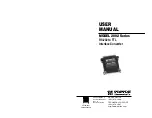
15
©2009 Smarter Tools, Inc. All Rights Reserved
1200 Generator
Operation
_________________________________________________________________________________________________
Starting
1. Make sure the generator is on a flat and level surface.
2. Make sure the electrical powered tools/equipment that will be used are not plugged into the generator while the
engine is started.
3. Turn the 120 volt AC circuit breaker to its “ON” position.
4. Turn the fuel valve to the “ON” position.
5. Pull the choke rod out.
6. Turn the engine power switch to its “ON” position.
7. For “Recoil Start”, hold the start handle loosely and pull it slowly several times to allow the gasoline to flow into the
engine’s carburetor. Then hold the start handle firmly and pull the rope hard and fast. Pull the rope all the way out,
using two hands if necessary. If necessary pull the rope several times until the engine starts.
8. Allow the engine to idle until warm. Then, slowly push choke rod in all the way.
Note:
If the engine starts but does not run, make certain that the generator is on a flat, level surface.
The engine is equipped with a low oil sensor that will prevent the engine from running when the oil level falls
below a critical threshold.
Surge Protection
CAUTION:
ATTEMPTING TO POWER SENSITIVE ELECTRONIC EQUIPMENT WITHOUT THE USE OF AN
APPROVED LINE CONDITIONER MAY CAUSE DAMAGE TO THE EQUIPMENT.
Electronic devices, including computers and many programmable appliances use components that are designed to operate
within a narrow voltage range and may be affected by momentary voltage fluctuations.
While there is no way to prevent voltage fluctuations, you can take steps to protect sensitive electronic equipment.
1.
Install UL1449, CSA-listed, plug-in surge suppressors on the outlets feeding your sensitive equipment.
Surge suppressors come in single- or multi-outlet styles. They’re designed to protect against virtually all short
duration voltage fluctuations.
2.
Obtain an Uninterruptible Power Supply (UPS) device. Most UPS devices come with a rechargeable battery
between the electronic equipment and power supply source. The device buffers the voltage and protects against
virtually all short duration voltage fluctuations.
Capacity
Follow these simple steps to calculate the running and starting watts necessary for your purposes.
See page 17 for Wattage Reference Guide.
1. Select the electrical devices you plan on running at the same time.
2. Total the running watts of these items. This is the amount of power you need to keep your items running.
3. Identify the highest starting wattage of all devices identified in step
a. Add this number to the number calculated in step
b. Surge wattage is the extra burst of power needed to start some electric driven equipment. Following the
steps listed under “Power Management” will guarantee that only one device will be starting at a time.















































